steering CADILLAC ESCALADE 2010 3.G Service Manual
[x] Cancel search | Manufacturer: CADILLAC, Model Year: 2010, Model line: ESCALADE, Model: CADILLAC ESCALADE 2010 3.GPages: 616, PDF Size: 39.41 MB
Page 391 of 616

Section 6 Driving Your Vehicle
Your Driving, the Road, and the Vehicle. . . . . . . . . . 6-2Defensive Driving . . . . . . . . . . . . . . . . . . . . . . . . . . . . . . . 6-2Drunk Driving . . . . . . . . . . . . . . . . . . . . . . . . . . . . . . . . . . . 6-2Control of a Vehicle . . . . . . . . . . . . . . . . . . . . . . . . . . . . . 6-3Braking . . . . . . . . . . . . . . . . . . . . . . . . . . . . . . . . . . . . . . . . . 6-4Antilock Brake System (ABS) . . . . . . . . . . . . . . . . . . . 6-5Braking in Emergencies . . . . . . . . . . . . . . . . . . . . . . . . . 6-6StabiliTrak®System . . . . . . . . . . . . . . . . . . . . . . . . . . . . . 6-6Magnetic Ride Control™. . . . . . . . . . . . . . . . . . . . . . . . 6-9Road Sensing Suspension . . . . . . . . . . . . . . . . . . . . . . 6-9Locking Rear Axle . . . . . . . . . . . . . . . . . . . . . . . . . . . . . . 6-9All-Wheel Drive (AWD) System . . . . . . . . . . . . . . . . . 6-9Steering . . . . . . . . . . . . . . . . . . . . . . . . . . . . . . . . . . . . . . . 6-10Off-Road Recovery . . . . . . . . . . . . . . . . . . . . . . . . . . . . . 6-11Passing . . . . . . . . . . . . . . . . . . . . . . . . . . . . . . . . . . . . . . . . 6-12Loss of Control . . . . . . . . . . . . . . . . . . . . . . . . . . . . . . . . 6-12Off-Road Driving . . . . . . . . . . . . . . . . . . . . . . . . . . . . . . . 6-13
Driving at Night . . . . . . . . . . . . . . . . . . . . . . . . . . . . . . . . 6-24Driving in Rain and on Wet Roads . . . . . . . . . . . . . 6-25Before Leaving on a Long Trip . . . . . . . . . . . . . . . . . 6-26Highway Hypnosis . . . . . . . . . . . . . . . . . . . . . . . . . . . . . 6-26Hill and Mountain Roads . . . . . . . . . . . . . . . . . . . . . . . 6-27Winter Driving . . . . . . . . . . . . . . . . . . . . . . . . . . . . . . . . . 6-28If Your Vehicle is Stuck in Sand, Mud, Ice,or Snow . . . . . . . . . . . . . . . . . . . . . . . . . . . . . . . . . . . . . 6-30Rocking Your Vehicle to Get It Out . . . . . . . . . . . . . 6-30Recovery Hooks . . . . . . . . . . . . . . . . . . . . . . . . . . . . . . . 6-31Loading the Vehicle . . . . . . . . . . . . . . . . . . . . . . . . . . . . 6-32
Towing. . . . . . . . . . . . . . . . . . . . . . . . . . . . . . . . . . . . . . . . . . . . 6-38Towing Your Vehicle . . . . . . . . . . . . . . . . . . . . . . . . . . . 6-38Recreational Vehicle Towing . . . . . . . . . . . . . . . . . . . 6-38Level Control . . . . . . . . . . . . . . . . . . . . . . . . . . . . . . . . . . 6-41Autoride®. . . . . . . . . . . . . . . . . . . . . . . . . . . . . . . . . . . . . . 6-42Towing a Trailer . . . . . . . . . . . . . . . . . . . . . . . . . . . . . . . . 6-42Trailer Recommendations . . . . . . . . . . . . . . . . . . . . . . 6-55
6-1
Page 393 of 616
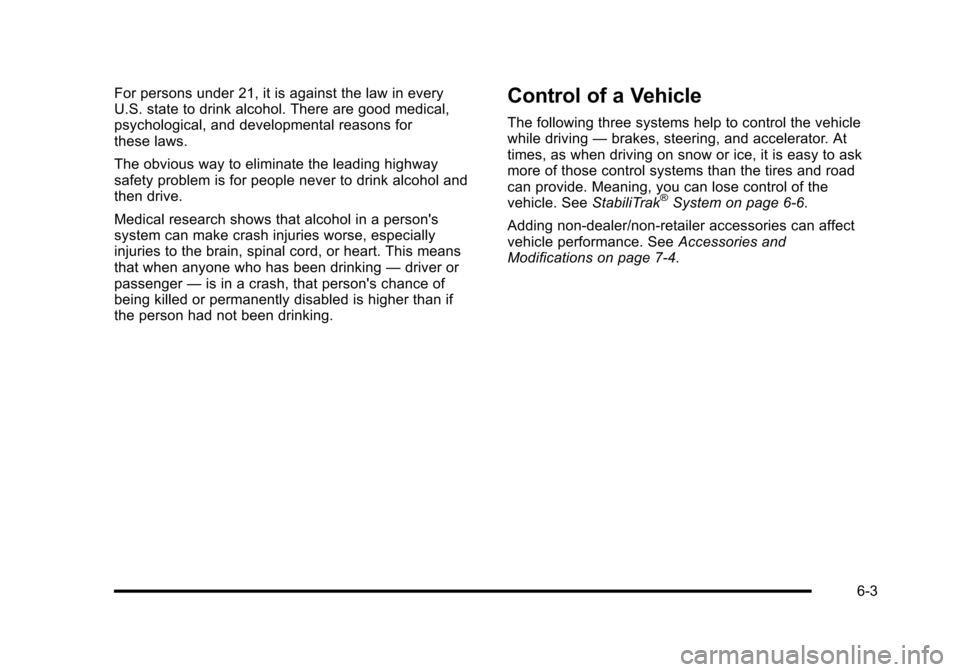
For persons under 21, it is against the law in everyU.S. state to drink alcohol. There are good medical,psychological, and developmental reasons forthese laws.
The obvious way to eliminate the leading highwaysafety problem is for people never to drink alcohol andthen drive.
Medical research shows that alcohol in a person'ssystem can make crash injuries worse, especiallyinjuries to the brain, spinal cord, or heart. This meansthat when anyone who has been drinking—driver orpassenger—is in a crash, that person's chance ofbeing killed or permanently disabled is higher than ifthe person had not been drinking.
Control of a Vehicle
The following three systems help to control the vehiclewhile driving—brakes, steering, and accelerator. Attimes, as when driving on snow or ice, it is easy to askmore of those control systems than the tires and roadcan provide. Meaning, you can lose control of thevehicle. SeeStabiliTrak®System on page 6!6.
Adding non!dealer/non!retailer accessories can affectvehicle performance. SeeAccessories andModifications on page 7!4.
6-3
Page 396 of 616

Using ABS
Do not pump the brakes. Just hold the brake pedaldown firmly and let antilock work. The brakes mightvibrate or some noise might be heard, but this isnormal.
Braking in Emergencies
ABS allows the driver to steer and brake at the sametime. In many emergencies, steering can help morethan even the very best braking.
Brake Assist
This vehicle has a Brake Assist feature designed toassist the driver in stopping or decreasing vehiclespeed in emergency driving conditions. This featureuses the stability system hydraulic brake control moduleto supplement the power brake system under conditionswhere the driver has quickly and forcefully applied thebrake pedal in an attempt to quickly stop or slow downthe vehicle. The stability system hydraulic brake controlmodule increases brake pressure at each corner of thevehicle until the ABS activates. Minor brake pedalpulsations or pedal movement during this time is normaland the driver should continue to apply the brake pedalas the driving situation dictates The Brake Assistfeature will automatically disengage when the brakepedal is released or brake pedal pressure is quicklydecreased.
StabiliTrak®System
The vehicle has a vehicle stability enhancement systemcalled StabiliTrak. It is an advanced computer controlledsystem that assists the driver with directional control ofthe vehicle in difficult driving conditions.
StabiliTrak activates when the computer sensesa discrepancy between the intended path and thedirection the vehicle is actually traveling. StabiliTrakselectively applies braking pressure at any one of thevehicle's brakes to assist the driver with keeping thevehicle on the intended path.
When the vehicle is started and begins to move, thesystem performs several diagnostic checks to insurethere are no problems. The system may be heard or feltwhile it is working. This is normal and does not meanthere is a problem with the vehicle. The system shouldinitialize before the vehicle reaches 20 mph (32 km/h).In some cases, it may take approximately two miles ofdriving before the system initializes.
If cruise control is being used when StabiliTrakactivates, the cruise control automatically disengages.The cruise control can be re-engaged when roadconditions allow. SeeCruise Control on page 4!8.
6-6
Page 397 of 616

If the system fails to turn on or activate, the StabiliTraklight along with one of the following messages will bedisplayed on the Driver Information Center (DIC):TRACTION CONTROL OFF, SERVICE TRACTIONCONTROL, STABILITRAK OFF, SERVICESTABILITRAK. If these DIC messages appear, makesure the StabiliTrak system has not been turned offusing the StabiliTrak on/off button. Then turn thesteering wheel clockwise from the nine o'clock positionto the three o'clock position. If this clears themessage(s), the vehicle does not need servicing.If this does not clear the message(s), then turn thevehicle off, wait 15 seconds, and then turn it back onagain to reset the system. If any of these messagesstill appear on the Driver Information Center (DIC), thevehicle should be taken in for service. For moreinformation on the DIC messages, seeDriverInformation Center (DIC) on page 4!41.
The StabiliTrak light willflash on the instrumentpanel cluster when thesystem is both onand activated.
The system may be heard or felt while it is working; thisis normal.
The traction controldisable button is locatedon the instrument panelbelow the climatecontrols.
The traction control part of StabiliTrak can be turnedoff by pressing and releasing the StabiliTrak button ifboth systems (traction control and StabiliTrak) werepreviously on. To disable both traction control andStabiliTrak, press and hold the button for five seconds.
Traction control and StabiliTrak can be turned on bypressing and releasing the StabiliTrak button if notautomatically shut off for any other reason.
When the TCS or StabiliTrak system is turned off,the StabiliTrak light and the appropriate TCS off orStabiliTrak off message will be displayed on the DIC towarn the driver. The vehicle will still have brake-tractioncontrol when traction control is off, but will not be ableto use the engine speed management system. See“Traction Control Operation”next for more information.
When the traction control system has been turned off,system noises may still be heard as a result of thebrake-traction control coming on.
6-7
Page 399 of 616

Magnetic Ride Control™
The vehicle may have the MagneRide control system.MagneRide constantly checks speed, wheel position,lift/dive and steering of the vehicle. The damping forcefor each shock absorber and adjustment level is chosenfor the best ride and handling.
MagneRide also works with the tow/haul switch that,when engaged, will provide more firmness from theshock absorbers. This added control gives better rideand handling when carrying heavy loads or towinga trailer. SeeTow/Haul Modeon page 3!36formore information.
Road Sensing Suspension
The Road Sensing Suspension (RSS) feature providessuperior vehicle ride and handling under a variety ofpassenger and loading conditions.
The system is fully automatic and uses a computercontroller to continuously monitor vehicle speed, wheelto body position, lift/dive and steering position of thevehicle. The controller then sends signals to each shockabsorber to independently adjust the damping level toprovide the optimum vehicle ride.
RSS also interacts with the tow/haul mode that, whenengaged, will provide additional control of the shockabsorbers. This additional control results in better rideand handling characteristics when the vehicle is loadedor towing a trailer. See“Tow/Haul Mode”underTowing aTrailer on page 6!42.
Locking Rear Axle
Vehicles with a locking rear axle can give more tractionon snow, mud, ice, sand or gravel. It works like astandard axle most of the time, but when traction is low,this feature will allow the rear wheel with the mosttraction to move the vehicle.
All-Wheel Drive (AWD) System
If the vehicle has this feature, engine power is sent toall four wheels when extra traction is needed. This islike four-wheel drive, but there is no separate lever orswitch to engage or disengage the front axle. It is fullyautomatic, and adjusts itself as needed for roadconditions.
If the vehicle is a Two-mode Hybrid, see“Four-WheelDrive”in the Two-mode Hybrid Supplement.
6-9
Page 400 of 616
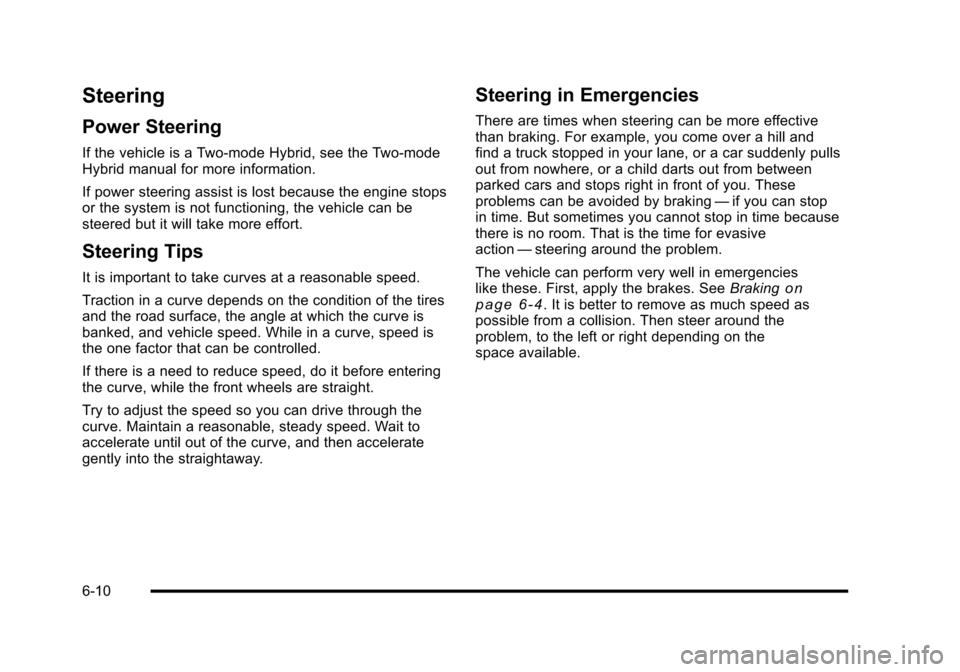
Steering
Power Steering
If the vehicle is a Two!mode Hybrid, see the Two!modeHybrid manual for more information.
If power steering assist is lost because the engine stopsor the system is not functioning, the vehicle can besteered but it will take more effort.
Steering Tips
It is important to take curves at a reasonable speed.
Traction in a curve depends on the condition of the tiresand the road surface, the angle at which the curve isbanked, and vehicle speed. While in a curve, speed isthe one factor that can be controlled.
If there is a need to reduce speed, do it before enteringthe curve, while the front wheels are straight.
Try to adjust the speed so you can drive through thecurve. Maintain a reasonable, steady speed. Wait toaccelerate until out of the curve, and then accelerategently into the straightaway.
Steering in Emergencies
There are times when steering can be more effectivethan braking. For example, you come over a hill andfind a truck stopped in your lane, or a car suddenly pullsout from nowhere, or a child darts out from betweenparked cars and stops right in front of you. Theseproblems can be avoided by braking—if you can stopin time. But sometimes you cannot stop in time becausethere is no room. That is the time for evasiveaction—steering around the problem.
The vehicle can perform very well in emergencieslike these. First, apply the brakes. SeeBrakingonp a g e 6!4. It is better to remove as much speed aspossible from a collision. Then steer around theproblem, to the left or right depending on thespace available.
6-10
Page 401 of 616
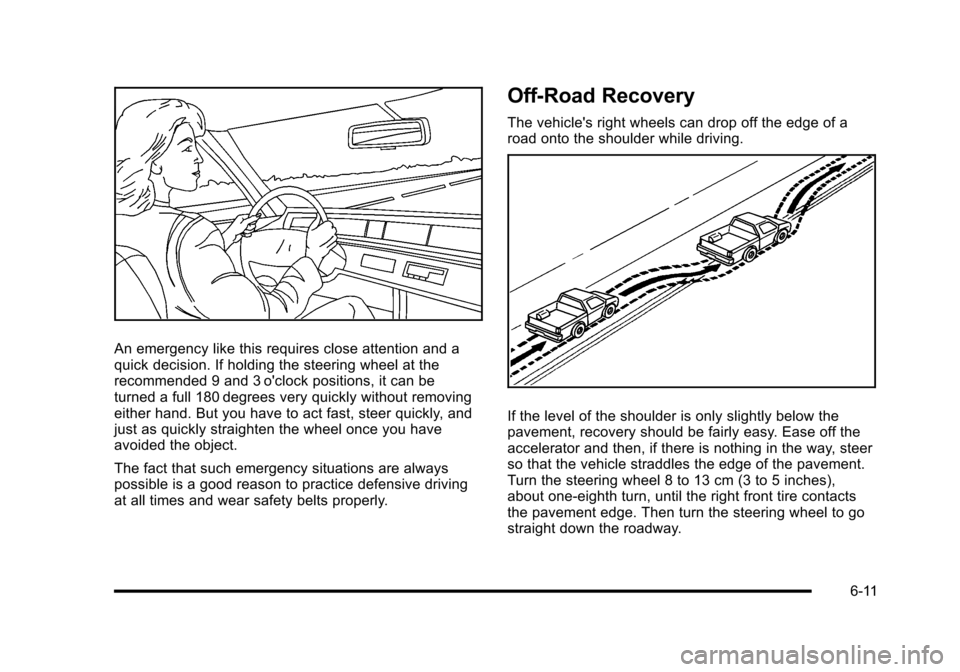
An emergency like this requires close attention and aquick decision. If holding the steering wheel at therecommended 9 and 3 o'clock positions, it can beturned a full 180 degrees very quickly without removingeither hand. But you have to act fast, steer quickly, andjust as quickly straighten the wheel once you haveavoided the object.
The fact that such emergency situations are alwayspossible is a good reason to practice defensive drivingat all times and wear safety belts properly.
Off-Road Recovery
The vehicle's right wheels can drop off the edge of aroad onto the shoulder while driving.
If the level of the shoulder is only slightly below thepavement, recovery should be fairly easy. Ease off theaccelerator and then, if there is nothing in the way, steerso that the vehicle straddles the edge of the pavement.Turn the steering wheel 8 to 13 cm (3 to 5 inches),about one-eighth turn, until the right front tire contactsthe pavement edge. Then turn the steering wheel to gostraight down the roadway.
6-11
Page 402 of 616
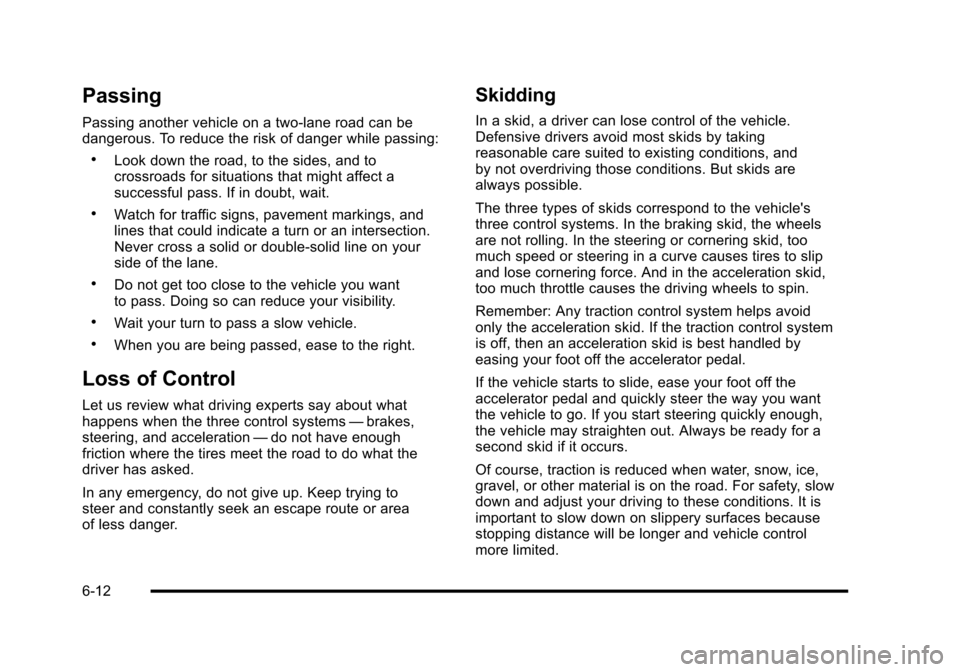
Passing
Passing another vehicle on a two-lane road can bedangerous. To reduce the risk of danger while passing:
.Look down the road, to the sides, and tocrossroads for situations that might affect asuccessful pass. If in doubt, wait.
.Watch for traffic signs, pavement markings, andlines that could indicate a turn or an intersection.Never cross a solid or double!solid line on yourside of the lane.
.Do not get too close to the vehicle you wantto pass. Doing so can reduce your visibility.
.Wait your turn to pass a slow vehicle.
.When you are being passed, ease to the right.
Loss of Control
Let us review what driving experts say about whathappens when the three control systems—brakes,steering, and acceleration—do not have enoughfriction where the tires meet the road to do what thedriver has asked.
In any emergency, do not give up. Keep trying tosteer and constantly seek an escape route or areaof less danger.
Skidding
In a skid, a driver can lose control of the vehicle.Defensive drivers avoid most skids by takingreasonable care suited to existing conditions, andby not overdriving those conditions. But skids arealways possible.
The three types of skids correspond to the vehicle'sthree control systems. In the braking skid, the wheelsare not rolling. In the steering or cornering skid, toomuch speed or steering in a curve causes tires to slipand lose cornering force. And in the acceleration skid,too much throttle causes the driving wheels to spin.
Remember: Any traction control system helps avoidonly the acceleration skid. If the traction control systemis off, then an acceleration skid is best handled byeasing your foot off the accelerator pedal.
If the vehicle starts to slide, ease your foot off theaccelerator pedal and quickly steer the way you wantthe vehicle to go. If you start steering quickly enough,the vehicle may straighten out. Always be ready for asecond skid if it occurs.
Of course, traction is reduced when water, snow, ice,gravel, or other material is on the road. For safety, slowdown and adjust your driving to these conditions. It isimportant to slow down on slippery surfaces becausestopping distance will be longer and vehicle controlmore limited.
6-12
Page 403 of 616

While driving on a surface with reduced traction, tryyour best to avoid sudden steering, acceleration,or braking, including reducing vehicle speed by shiftingto a lower gear. Any sudden changes could cause thetires to slide. You may not realize the surface is slipperyuntil the vehicle is skidding. Learn to recognize warningclues—such as enough water, ice, or packed snow onthe road to make a mirrored surface—and slow downwhen you have any doubt.
Remember: Antilock brakes help avoid only thebraking skid.
Off-Road Driving
Vehicles with all!wheel drive can be used for off!roaddriving. Vehicles without all!wheel drive and vehicleswith 22!inch tire/wheel assemblies should not be drivenoff-road except on a level, solid surface.
Many of the vehicle design features that help make thevehicle more responsive on paved roads during poorweather conditions also help make it better suited foroff!road use than conventional passenger vehicles.The vehicle does not have features usually thought tobe necessary for extended or severe off!road use suchas special underbody shielding and transfer case lowgear range.
The airbag system is designed to work properly under awide range of conditions, including off!road usage.Always wear your safety belt and observe safe drivingspeeds, especially on rough terrain.
Drinking and driving can be very dangerous on anyroad and this is certainly true for off-road driving.At the very time you need special alertness and drivingskills, your reflexes, perceptions, and judgment can beaffected by even a small amount of alcohol. You couldhave a serious—or even fatal—accident if you drinkand drive or ride with a driver who has been drinking.
Off-roading can be great fun but has some definitehazards. The greatest of these is the terrain itself. Whenoff-road driving, traffic lanes are not marked, curves arenot banked, and there are no road signs. Surfaces canbe slippery, rough, uphill, or downhill.
Avoid sharp turns and abrupt maneuvers. Failure tooperate the vehicle correctly off!road could result in lossof vehicle control or vehicle rollover.
Off-roading involves some new skills. That is why it isvery important that you read these driving tips andsuggestions to help make off-road driving safer andmore enjoyable.
6-13
Page 407 of 616
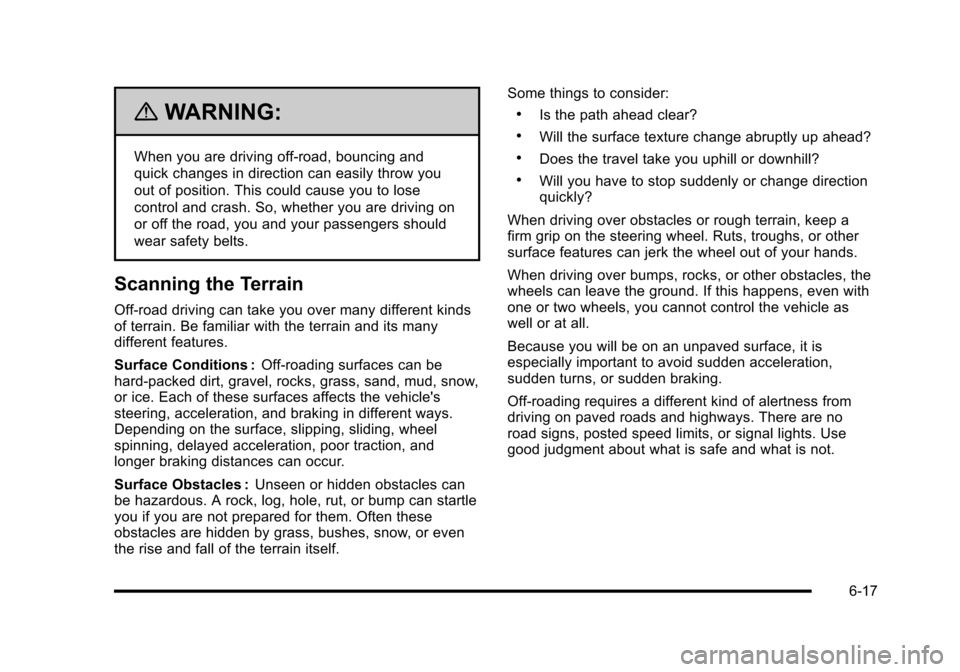
{WARNING:
When you are driving off-road, bouncing and
quick changes in direction can easily throw you
out of position. This could cause you to lose
control and crash. So, whether you are driving on
or off the road, you and your passengers should
wear safety belts.
Scanning the Terrain
Off-road driving can take you over many different kindsof terrain. Be familiar with the terrain and its manydifferent features.
Surface Conditions :Off-roading surfaces can behard-packed dirt, gravel, rocks, grass, sand, mud, snow,or ice. Each of these surfaces affects the vehicle'ssteering, acceleration, and braking in different ways.Depending on the surface, slipping, sliding, wheelspinning, delayed acceleration, poor traction, andlonger braking distances can occur.
Surface Obstacles :Unseen or hidden obstacles canbe hazardous. A rock, log, hole, rut, or bump can startleyou if you are not prepared for them. Often theseobstacles are hidden by grass, bushes, snow, or eventhe rise and fall of the terrain itself.
Some things to consider:
.Is the path ahead clear?
.Will the surface texture change abruptly up ahead?
.Does the travel take you uphill or downhill?
.Will you have to stop suddenly or change directionquickly?
When driving over obstacles or rough terrain, keep afirm grip on the steering wheel. Ruts, troughs, or othersurface features can jerk the wheel out of your hands.
When driving over bumps, rocks, or other obstacles, thewheels can leave the ground. If this happens, even withone or two wheels, you cannot control the vehicle aswell or at all.
Because you will be on an unpaved surface, it isespecially important to avoid sudden acceleration,sudden turns, or sudden braking.
Off-roading requires a different kind of alertness fromdriving on paved roads and highways. There are noroad signs, posted speed limits, or signal lights. Usegood judgment about what is safe and what is not.
6-17